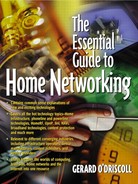ABOUT JINI CONNECTION TECHNOLOGIES
Jini is Sun Microsystems' home networking software solution. It is a layer of Java software that allows devices to plug directly into a home network without the hassle of installing drivers and configuring operating systems. In some ways the history of Jini is the history of Java—Jini is really the fulfillment of the original Java vision of groups of consumer-orientated electronic devices interchanging data and bits of code. This vision requires mechanisms that we don't typically associate with desktop computers.
The software infrastructure for these consumer and in-home appliances must be incredibly robust. Toasters and washing machines simply cannot fail with a message asking "Abort, Retry, or Ignore?" The software must not only allow, but also encourage, the development of reliable systems.
In-home devices have to support true, effortless "plug and play." For all intents and purposes they should be the in-home equivalents of the Internet. You plug them in and they just work. There are a couple of requirements that this desire for plug and play imposes. First, devices must be easy to use. Much like a standard telephone, typical consumer appliances may have only a limited number of interfaces. Certainly not every device at home will have a mouse and a high-resolution display. In fact, most consumers will not want such interfaces for these devices—if they require a mouse or keyboard, chances are they're too hard to use. Second, in-home devices need to be easy to administer. Most people would like to plug them in and use them, without having to configure IP addresses for them, set up gateways and routers, install (and possibly) remove drivers, and so on. Upgrades of software are an important issue here—if an IT professional needs to be called in to upgrade all appliances on a home network, chances are the appliances simply won't get upgraded.
Software systems for the Internet age need to be evolvable. While creating software for stand-alone devices, such as a CPU for a microwave, is challenging enough, the potential problems are multiplied by the fact that networked devices on your in-home network must be able to communicate with any number of peer devices on the Internet.
The vision of legions of devices and software services working together simply and reliably had been espoused by a number of researchers and computer industry leaders before. Mark Weiser of the Xerox Palo Alto Research Center called this vision "ubiquitous computing," a term meant to connote the ready availability and usability of devices connected to a network. With this vision in mind, a group at Sun set out to provide the infrastructure that would bring Java full circle—this project became known as Jini. The creators of the system chose the name Jini because it is an energetic and easy-to-remember word that begins with "J" and has the same number of letters as "Java." The Jini project went on at Sun, hidden from public eyes, until New York Times technology reporter John Markoff broke the story in a front-page article in 1998. On January 25, 1999, the technology was officially made available to the public with a host of licensees already on board. These partners are building Jini-enabled services and devices, including hard drives, digital cameras, handheld computers, and much more. For its part, Sun is rapidly aligning behind Jini, in much the same way it aligned behind Java back in 1995. At the time of this writing, Jini has already been licensed by nearly 40 companies that run the gamut from home device vendors to enterprise software companies. These include disk drive manufacturers such as Quantum and Seagate; cellular phone manufacturers Nokia and Ericsson; printer vendors including Xerox, Canon, Epson, and Hewlett-Packard; camera manufacturer Kodak; networking vendors Cisco and 3Com; software producers BEA Systems, Novell, and Inprise; and a huge number of consumer electronics companies including Sony, Sharp, Philips, and Toshiba. Jini has also been licensed by companies as diverse as AOL and Kinko's.
